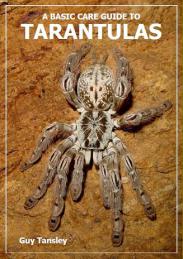
The genus Pamphobeteus Pocock, 1901 contains
some of the largest terrestrial tarantulas available in the hobby (up to 16 cms legspan). Most are stocky in appearance and colours range from pale brown through to stunning jet black with pink and
even blue markings to the carapace (especially found in juvenile specimens). Not overly defensive, they are more nervous and will readily kick urticating hair at the slightest disturbance. For this
reason, a retreat is beneficial, allowing the spider the security this will provide. Most are voracious feeders and grow relatively fast, their appearance changing quite a lot as they grow. Certain
species have a beautiful 'Christmas tree' pattern on their abdomens but this will eventually fade as the spider grows but unfortunately most reach maturity as various shades of brown. Proper
identification of Pamphobeteus spp. is difficult due to this general colouration
so care should be taken to prevent hybridisation (there are many unidentified species in the hobby labelled such as Pamphobeteus sp. 'Ecuador' etc.
but all can be kept under similar conditions). Males possess tibial apophysis and mating is usually a calm affair, using vibrations and loud stridulation in their courtship. A cricket-based diet is
sufficient but they will accept the occasional defrosted pinkie mouse or piece of lean, raw beef. Typical terrestrial set-up is ideal. Cork bark/flower pot hide with a deep substrate of moist compost
vermiculite mix. Due to their large size, Pamphobeteus spp. Will benefit from a slightly larger than
normal cage. Cage height should not be too high as this genera are poor climbers and a fall from even a small height may cause problems. More on housing can be found here. Wide
ranging throughout the rainforest regions of South America, average temperatures and humidity
are sufficient (75oF / 70%). Breeding can be unpredictable and infertile eggsacs are common. If successful, eggsacs contain several hundred spiderlings.
Common species in captivity:
P. antinous - Pocock, 1903
Peru, Bolivia
A very large and robust species from the rainforest areas of Bolivia. The femora of the legs have a bright blue colouration, especially apparent in mature males. Not that common in
collections.
P. fortis - (Ausserer, 1875)
Colombia
A large brown species from Colombia that has the distinctive 'Christmas tree' markings on the abdomen as spiderlings and juveniles. This fades as the spider
grows.
P. nigricolor - (Ausserer, 1875)
Colombia to Bolivia
Another dark brown to black large species that has the distinctive 'Christmas tree' markings on the abdomen as spiderlings and juveniles.
P. ornatus - Pocock, 1903
Colombia
Mature males are particularly striking being coloured with purple/pink to the legs and a starburst of colour to the carapace. Females remain dark brown to
black.
P. ultramarinus - Schmidt, 1995
Ecuador
Another brightly coloured species, females retaining some colour to the femora of the legs and the carapace as they grow, especially around the ocular
tubercle.
Pamphobeteus sp 'platyomma' -
(un-described) Ecuador
Although still un-described, this species has been in collections for years. Females are large and range in colour from light brown through to black depending on the proximity of a moult. Females
have a pinkish area around the ocular tubercle and males are distinctive with their pink leg markings and vivid pink colouration to their
carapace.

